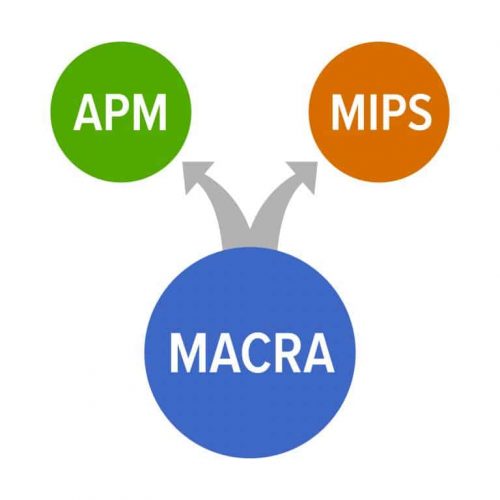As children, we remember hearing that “an apple a day keeps the doctor away.” While this Welsh proverb may not be based on scientific evidence, it was meant to remind us to do what we can to remain healthy. In today’s MACRA physician payment model, it’s closer to the truth than ever before as clinicians will be reimbursed for how healthy we are. The paradigm has shifted. Now it’s value-centered healthcare intending to preserve general health, well-being and quality clinical outcomes, metrics that determine clinicians’ Medicare payments for services. Providers now have a vested financial interest in a pay-for-performance model, which further motivates them to keep us healthy.
What is the Medicare Access and CHIP Reauthorization ACT?
The Medicare Access and CHIP Reauthorization Act of 2015 (MACRA) impacts the foundational framework for participating physicians’ reimbursements and payments beginning in 2021. Bipartisan legislation initiated the Quality Payment Program. This extensively altered the way medical professionals and institutions receive Medicare disbursements. The new structure rewards healthcare providers for value and quality of services provided rather than volume of patients served.
To buy additional time for implementation, the Centers for Medicare and Medicaid Services (CMS) fostered and gathered significant feedback before publishing the prevailing crossover directives of the 2019 Medical Quality Payment Program. This included input from from medical professionals and the community. CMS decided to delay the implementation of the controversial alterations.
<< In a statement, CMS administrator Seema Verma said, “The rule offers immediate relief from onerous requirements that contribute to burnout in the medical profession and detract from patient care. It also delays even more significant changes to give clinicians the time they need for implementation and provides time for us to continue to work with the medical community on this effort.”>>
This will allow the necessary time to create pathways for private practices, physicians, clinicians and institutions. Also, to determine how the new model will affect revenues and patient care within their respective systems.
Why did MACRA come about?
MACRA is a pay-for-performance model program template. Its big-picture goal and purpose is to incentivize medical practice by compensating healthcare providers for improving patients’ general health. This is done by concentrating on quality, value and accountability in the delivery of good medical care.
What is MACRA’s basic structure?
Physician reimbursement under MACRA stipulates a 0.5% increase in physician payment during the first four years. Beginning in 2019, Medicare payments are connected to the efficient delivery of healthcare and the quality of services provided. Within MACRA is the Quality Payment Program (QPP). This comprises two tracks, with selection between them based on the traits and characteristics of the physician’s practice.
The Merit-Based Incentive Payment System (MIPS) is one of the tracks. MIPS is a hybrid, combining elements of current programs with new methods of paying eligible clinicians (ECs) for services. Payment is based on the clinician’s use of certified electronic health record technology (CEHRT), quality of care best practices, clinical practice improvement actions and resource use.
The second track of the QPP compensates healthcare providers participating in alternative payment models (APMs). These are value-based models similar to accountable care organizations (ACOs) for Medicare beneficiaries.

Who does MACRA affect?
The ever-growing regulations of these programs affect not only physicians and other healthcare professionals, but also institutions, hospitals and their partners. Societies are working to prepare and assist in the implementation.
MACRA will radically affect clinical coding review, pre-authorizations for services, claim reimbursements, performance measures, policy development and coordination of care across organizations. Managed care professionals and Medicare providers have new defining roles and responsibilities. Under the plan, various components determine the calculation of payments, including malpractice costs, geographical regions, wages and physician service.
For patients, this means that starting in 2020, zero-deductible Medigap plans will no longer be available. The reasoning is that patient over-utilization of services will be reduced if individuals have a financial cost.
Also for pharmaceutical corporations, MACRA will <<“change how clinicians view and use drugs, especially those that are physician-administered. Clinicians will be seeking to demonstrate the value of the care they provide – including value provided through the use of drug treatments,”>> noted Jodi Reynolds, Deloitte’s principal Lifesciences strategist.
According to Dr. William Osler (1849-1919), <<“A good physician treats the disease. The great physician treats the patient who has the disease.”>> Thanks to MACRA, this enlightened philosophy from the father of modern medicine has now become the package Medicare model for the millennium.
Snowfish is a strategic consulting company which is called upon by leading life science companies to empower their approach to stakeholder engagement, advocacy, and market challenges. We are recognized as a trusted partner. Please reach out to us at info@snowfish.net to learn more.
- Market Access: The Latest Hurdle for Treating Alzheimer’s and Dementia - June 14, 2023
- Rare Disease Outreach a Missed Opportunity - November 7, 2022
- So You Read Our Previous Post on Biomarkers? - August 1, 2022



